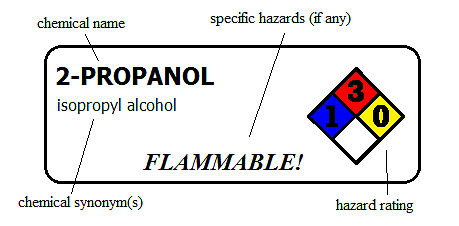Chemical Labels
Chemical Labels
Reagent bottles are labeled using a system which includes a "hybrid" hazard labeling system.
When reagents arrive from the manufacturer, the labels are intended to communicate the hazards and precautions of handling a particular chemical to the researchers and professionals who will be using the chemical. Much of this information is also included in compliance with HCS legislation, to protect the manufacturer from liability for any accidents which occur during handling of the chemical.
Unfortunately for students in undergraduate-level teaching labs, this information carries little meaning, or is simply not interpreted correctly because the average undergrad hasn't had the training and education to fully understand the information presented. Therefore the CS uses a simpler labeling system for the reagent bottles used by the students in the teaching labs. This system is a "hybrid" because it presents important information in a simpler and clearer format which is easy to understand, and also incorporates elements of both the NFPA and HMIS hazard labeling systems.
Here's an example of the labeling system we use:
The label consists of several parts:
-
Chemical name: Lists the name of the chemical. Many chemicals have several synonyms due to various systems of nomenclature. This can get a little confusing, so the most commonly-used name (according to the texts used for the teaching labs, but more often the name recommended by the IUPAC nomenclature system) will appear here.
-
Chemical synonyms: Lists other names of the chemical, if there are any. For instance, "rock salt" would be listed as a synonym of the chemical "sodium chloride."
-
Hazard rating: The hazard rating of the chemical. These ratings are usually published by the NFPA as Standards (NFPA 49 and 325, for example). If a chemical has no published NFPA rating, then HMIS/HMIG ratings are used instead, based on manufacturer information. A blank hazard rating on a chemical does not mean the chemical is harmless! On the contrary; it means that the chemical has not been rated by the NFPA or is not contained in any other published source of hazard ratings. Chemicals with blank hazard ratings should be treated as dangerous. Reagents which are not pure chemicals (for instance, aqueous salt solutions) will not include a hazard rating diamond on their labels.
-
Specific hazards: Based on the hazard rating, words appearing here draw your attention to specific hazards of the chemical or reagent. CORROSIVE! or POISON! will appear if the health (blue) rating is 3 or greater. FLAMMABLE! will appear if the flammability (red) rating is 3 or greater. EXPLOSIVE! or EXTREMELY REACTIVE! will appear if the reactivity (yellow) rating is 3 or greater, and WATER-REACTIVE! will appear if the chemical or reagent is water-reactive. In cases where the hazard rating is unknown, specific hazards may still be known and will be identified.